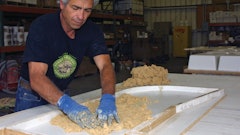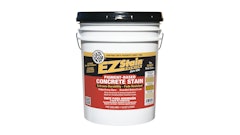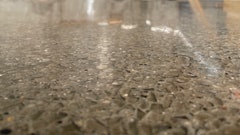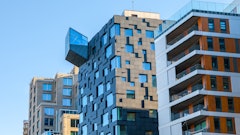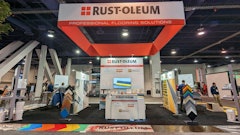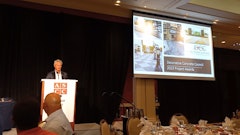
To the average person the word concrete often invokes the idea of cold, sterile, and grey. It isn’t hard to see why. Typically the concrete one encounters tends to be utilitarian material for sidewalks or bridges where aesthetics takes a back seat to function and cost. The expanding interest in decorative concrete is starting to challenge this concept however, transforming from a cold mass buried under the ground into inviting decorative surfaces for showing off to guests. Interest in customized concrete grows, so does the desire for greater variety of colors.
Coloring Concrete
Pigment selection, the type of cement, aggregate size and color, water content, mixing technique and finishing methods all have a role to play in the overall final appearance of the decorative concrete surface. Cement color is the starting point and the determining factor in what range of colors can be achieved. 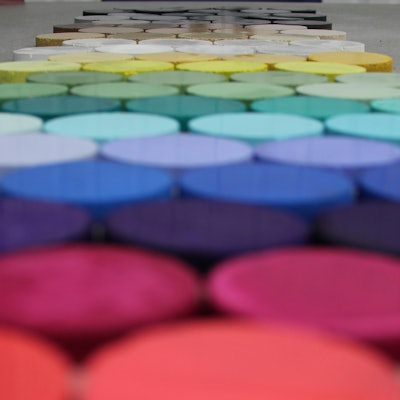
Cement
White cement provides a greater range of color possibilities and should be considered for bright and vibrant colors. White cement also yields greater reproducibility and consistency of color. For maximum brightness, particularly in the light pastel shades, white cement and the whitest aggregates should be used. Grey cements can vary greatly between suppliers, from batch to batch, and green undertones can alter the final appearance of the desired color. Given the higher levels of iron and other impurities in grey cement, the color selection is limited to muted earthy tones.
Aggregates
Typically there are two gradations of aggregates in a concrete product. Coarse, consisting of gravel, crushed stone, pumice, expanded shale, slag or limestone. Fine, consisting of silica sand, rock dust or manufactured stone sand. Aggregate color and size will impact the appearance of decorative concrete. This impact is directly related to the degree of exposure of the final concrete surface. A heavily exposed coarse aggregate will detract for the concrete color and the human eye will typically see the aggregate color.
Water
Water not only makes a concrete mix workable, but also enters into chemical combination with the cement. The quantity of water used in a mix controls to a large degree the durability, strength and water tightness of a concrete product. The higher the water content of the mix, the lighter the color. Control of the water/cement ratio is vital for consistent color from batch to batch.
These are factors beyond the pigment that can play a role in the final appearance of the product. Pigments used in concrete can be used individually or mixed to achieve a desired color, but one must have an idea of how the pigments behave in particular mixes in order to achieve a good match.
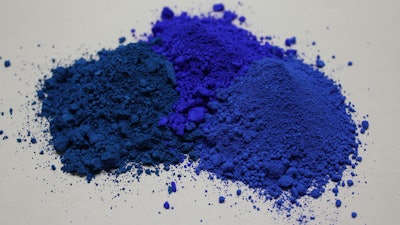
Introduction to Pigment
Pigments are insoluble particles that absorb certain wavelengths of light while reflecting other wavelengths allowing colors to be observed. The shape and size of pigment particles plays an important role in light reflection. Pigment particles can be spherical, rod shaped, plate-like, or irregular depending on individual chemistries. The shape can alter the rheology of the material and can have an impact on the water demand in some cases. It is important to test a pigment in a smaller sample in order to make necessary adjustments.
Hydrated cement, by its nature, is a harsh chemical environment for most materials, and for pigments specifically. Care must be taken to choose pigments that can survive the chemical reactions as the concrete cures since pigment becomes incorporated into the concrete matrix. Post cure, the pigments must survive long term UV exposure.
More on Dyes, Stains & Pigments
What is the Difference Between Concrete Dyes, Stains and Pigments? Understanding the difference between concrete dyes, stains and pigments is essential when deciding which to use for colored concrete. Use this high value asset infographic to make the correct decision. Download this free infographic.
Inorganic Pigments
The industry standard for integral color in concrete, ASTM C979, spells out requirements and test procedure for pigments used in concrete and specifies inorganic pigments as the preferred pigment of choice. Inorganic pigments are chemically stable, and typically won’t have adverse effects on the concrete as long as used within recommended ranges, typically less than 10 percent of the cement content by weight. Synthetic iron oxide pigments are inexpensive and there is a wide enough variety to achieve many desired earth tone colors. Naturally occurring ochres and umbers contain iron oxide along with other minerals and also produce unique shades of assorted earth tones. Chromium oxide provides a stable green pigment. Titanium dioxide is useful for achieving light colors, whites, as well as making light grey when used in grey cement. Cobalt oxides allow for various blues and teals but can also be more expensive than other oxide based pigments.
Organic Pigments
Breaking the color barrier for concrete is achieved by using organic pigments in combination with inorganic pigments. Organic pigments are brighter, much stronger, and cleaner than the oxides and thus can help achieve deeper colors than with oxides alone. Organic pigments can affect water demand and cure time, among other side effects. Carbon black is one of the most common organic pigments used in concrete, and there are limits to its use. Copper phthalocyanine pigments offer various shades of blue and green. Research is constantly underway to find suitable organic pigments for use in concrete. The use of these pigments requires some expertise and many new chemistries have been developed since the implementation of ASTM C979. There are now bright yellows, reds, and violets on the market that can expand the possibilities of concrete color.
Using Color in Cement
Controlling color in concrete requires an understanding of the amount of cementitious material in the mix. Cement and pozzolans combine to form the total cementitious binder or TCB. The amount of pigment required to achieve a given color is referred to as the “loading rate.” Multiplying the TCB by the loading rate produces the amount of pigment necessary for the job.
Formulating Color and Color Matching
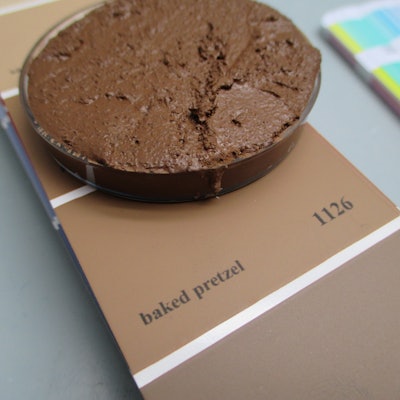
Rather than relying on the trial and error approach, Delta has the experience and resources to optimize color matching. Technology is a helpful aid in the color matching process, primarily relying on the spectrophotometer. This piece of equipment reflects light off a sample and translates the data into a three dimensional graph allowing a more objective analysis of color. This graph allows easy comparison between a sample to match and the sample being tested allowing precise adjustments to be made to the formula. Consistency in the mixing process is also key to successful color formulation. In order to achieve reproducible results, measurements must be made on accurate scales and the mixing must be done in a way that reduces human error. Verifying colors under a light booth with different light sources is also a key step in the color process due to the phenomenon of metamerism in which colors vary based on lighting conditions.
As interest grows in decorative concrete there will be a corresponding increase in the interest of concrete color. Understanding the available technology will be an important part of maintaining customer satisfaction as color becomes a more important aspect of the concrete industry.











